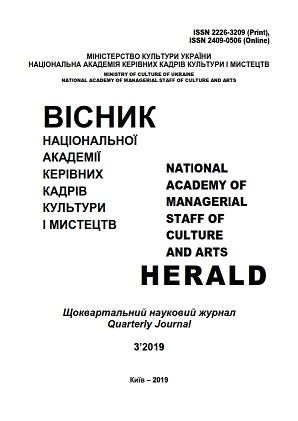Author(s): Elena Mykolayivna Markova / Language(s): Ukrainian
Issue: 1/2019
The purpose of the article given studies is a trailing of profound relationship to the leading notion of art studies and philosophic- religious sense mortgaged in numerology and other symbology of genre-technique indications of the music. Methodology of the study emerges the hermeneutic accumulation in the work of A.Losev, E. Wilson-Dickson, in musicology - a developments B.Asafiev, B.Yarustovskiy and others. The hermeneutic cut of art-studies analysis, with a handhold on historian-stylistic, sоcio-culturology principles in comparison of semantic position to epochal filling forms the concreteness of the applying methods of the cognition of the brought forth theme of the study. Scientific novelty of the work is defined by originality to ideas of the collation of value philosophical-religious generalizations, in tradition A.Losev and B.Asafiev, and factors of the form in artistic buildings. Is it for the first time attention to semantic parallels of the beliefs about epochal change the form from the Middle ages before New time - in development position to music sociology, as they are declared in work A.Lunacharskiy, T.Adorno, B.Asaiev, L.Mazel, and other prominent researchers of art, leaving on the hermeneutic factors of the incidence of the sense artistic-formal quality of the expression. Conclusions. The total of the offered review is, first, understanding that that music contents and sense concentrated in the symbology of the music forms - as invoiced wholeness which presents the unity of the expressive facilities in general, and as structured concreteness of the forms-schemes to compositions. The semantic essence and the first, and the second related religious, philosophical ideas, given birth history condition, which become nourishing headwaters and for epochal determined music buildings that are to say obviously their genetic alliance. Secondly, music sociology, as one of leading discipline to hierarchies forming in culturology of musics, contains hermeneutic component, which forms the foundation of the music semiotics, music semioties, music hermeneuties as such as a whole, jointly teachings about music contentrichness and music image, which were in the highlight classical musicology past two centuries.
More...







